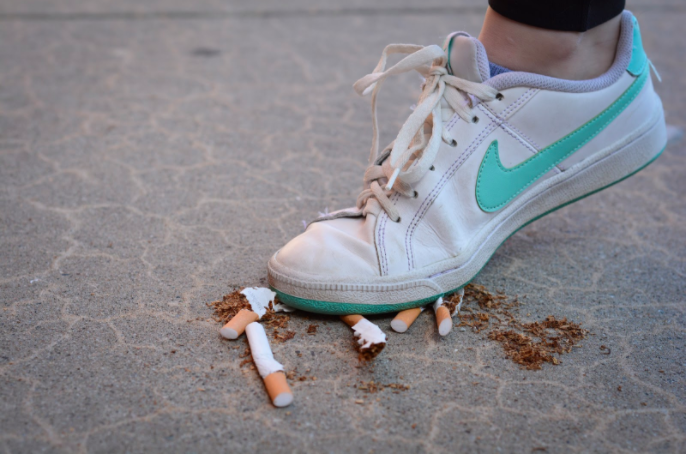By: Molly Liebergall ’17 and Daniel Harizman ’19
Drug Abuse Resistance Education, more commonly known as D.A.R.E., is a nationwide program dedicated to “teaching students decision making for safe and healthy living,” according to its website. Most Staples students are familiar with the acronym, and with the memory of a local police officer visiting their fifth grade classes to teach a wide range of lessons, all the while emphasizing the dangers of drugs, drinking and cigarettes.
According to the CDC’s National Youth Tobacco Survey, student usage of cigarettes has decreased from over 15 percent to less than 10 percent between 2011 and 2015. Despite this trend, some Staples students still smoke.
*Jess Clark ’17, who suffers from depression, ADHD and borderline split personality disorder, began smoking this past June.
“It started kind of as a self-medicating thing,” she said, adding that her boyfriend at the time was a chain-smoker, which, combined with mental illness and identity struggles, caused her to pick up her first cigarette. “Because I was so confused about who I was, it gave me a more clear box to put myself in.”
From June to December, Clark smoked two to three packs of Marlboro Reds per week before a friend helped her quit. After withstanding three days of the violent shakes and agitation that accompany withdrawal, she successfully kicked her habit—that is, until January.
Now, Clark smokes less, only a couple times per week, but is still susceptible to, and completely aware of the dangers.
“I remember all of the health s***. I know how bad it is for you. I’ve seen the commercials, lung pictures, and all of that,” she said.
The “health s***” to which Clark referred was in reference to the information taught to students in fifth grade through the D.A.R.E. program, and again in high school during health class.
“[Cigarette smoking] is the leading cause of preventable disease and death in the United States,” CDC Office on Smoking and Health (OSH) Epidemiologist Tushar Singh, M.D., said. “It has been shown to cause over a dozen different types of cancer, and kills approximately 480,000 Americans each year.”
Ironically, Clark acknowledged that one of the main reasons she smokes is because she knows from the D.A.R.E. program and from her grandfather’s fatal lung cancer how unhealthy it is. “It’s just the same idea as being self-sabotaging,” Clark explained. Also, as someone struggling with mental illness and a rough upbringing, using cigarettes habitually functions as a form of structure and a temporary distraction from the overwhelmingly intense emotional responses she experiences because of her specific disorder.
“If you don’t have depression or something like that, you’re not going to want to do something super unhealthy,” she said. “I’m trying to figure s*** out, so hopefully at some point I’ll be like ‘I don’t want to destroy myself’ and I’ll stop, but at the moment I can’t foresee really trying to quit soon.”
Although Clark wants to stop using cigarettes in the future, there is a possibility that she will fail, as is supported by The National Institutes of Health reports citing that approximately 30 percent of teenage smokers will continue smoking into adulthood and die early from a smoking-related disease.
Newer preventative measures, like Truth’s #FinishIT campaign and the CDC’s “Tips from a Former Smoker” advertisements, aim to reduce this number to zero.
“Cigarettes’ role in the social scene back when I was a high schooler was primarily to allow kids who had not known each other prior to their encounter to bond and connect less awkwardly,” Aiden Smith, long time Westport psychologist explained. “It baffles me how teenagers still choose to smoke cigarettes, even though the media industry has been relentlessly advertising against smoking as a whole.”
Since the first electronic cigarette in 2003, various forms of “E-Cigs” have also become intertwined with the Staples social scene.
To *Robert Jones ’19, high school is comprised of a thick vortex of peer pressure, cliques and a series of personal attempts made at furthering social recognition. Jones’ difficulty in finding his place inside the community of friend groups at Staples led him to smoke his JUUL—a type of E-Cig invented in 2015.
“I believe that ripping JUUL is almost entirely social; there is really no reason to do it besides fitting in or trying to be ‘cool,’” Jones said. “When I use my JUUL, it’s because I want to be able to socialize with others who similarly used JUUL.”
Although cigarettes have nationally decreased in popularity over the past few years, “E-cig” usage has increased during the same period of time. In a CDC study about youth national tobacco in 2011, only about two percent of students reported using electronic smoking devices, which skyrocketed to more than 15 percent in 2015.
“This increase is due to the prominent advertising of these products, including on television, where cigarette advertising has been banned in the United States since the early 1970’s,” Singh said. “E-cigarettes are also available in a wide variety of flavors that are particularly appealing to young people[…]and are also a novel product that many youth report being curious about.”
JUUL holds a small battery that vaporizes interchangeable, flavored pods containing the ominously-named “e-liquid” upon inhalation. This liquid, which was manufactured in the company’s laboratories, consists of several chemicals, including Benzoic Acid—a naturally occurring chemical found in the tobacco plant—and Glycerol and Propylene Glycol, which are two common ingredients in consumer products like toothpaste.
Each JUUL pod contains 0.7 milliliters of juice. 5 percent of this is nicotine by weight, which is the same amount found in one pack of cigarettes.
“I use JUUL for the buzz,” *Bobby Edwards ’19 said. “I began last year when I saw that the more popular kids were doing it; ever since then I have had my own JUUL, finishing about 4-5 pods a week. I recognize the health-related disadvantages, but at this point I am too far in to stop. I have simply given up.”
JUUL and other e-cigarettes produce a less harmful aerosol. Nevertheless, “no tobacco or e-liquid product should ever be considered ‘safe,”’ according to the JUUL website itself.
“The long-term effects of e-cigarette use are not well known, mainly because these products have not been around long enough for scientists to fully study the health effects,” Singh said. “However, we do have enough science to show that the use of any tobacco products, including e-cigarettes, is unsafe for youth[…]Nicotine use during adolescence and young adulthood has been associated with lasting cognitive and behavioral impairments, including effects on working memory and attention.”
However, students similar to *Matthew Parker ’17, who use JUUL, often reach a certain point where they disregard the health-related issues, and enjoy their time as young adolescents.
“When you are incapable of running a mile because of an excessive use of nicotine products, you must come to a realization that your addiction needs to be treated,” Parker said. “With that said, I am not worried about the future. I’m 18 years old. These are some of the best years of my life. Why not live the dream?”












































